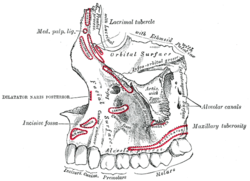- Maxillary tuberosity
-
Bone: Maxillary tuberosity Left maxilla. Outer surface. (Maxillary tuberosity labeled at center right.) Latin tuber maxillae Gray's subject #38 158 At the lower part of the infratemporal surface of the maxilla is a rounded eminence, the maxillary tuberosity, especially prominent after the growth of the wisdom tooth; it is rough on its lateral side for articulation with the pyramidal process of the palatine bone and in some cases articulates with the lateral pterygoid plate of the sphenoid.
It gives origin to a few fibers of the Medial pterygoid muscle.
External links
- SUNY Labs 22:os-0704 - "Osteology of the Skull: Inferior Surface of Skull"
- SUNY Labs 34:os-0302 - "Oral Cavity: Maxilla"
- Image at unc.edu
This article was originally based on an entry from a public domain edition of Gray's Anatomy. As such, some of the information contained within it may be outdated.
Bones of head and neck: the facial skeleton of the skull (TA A02.1.08–15, GA 2.156–177) Maxilla SurfacesAnterior: fossae (Incisive fossa, Canine fossa) · Infraorbital foramen · Anterior nasal spine
Infratemporal: Alveolar canals · Maxillary tuberosity
Orbital: Infraorbital groove · Infraorbital canal
Nasal: Greater palatine canalProcessesOtherZygomatic Palatine FossaePlatesProcessesMandible external surface (Symphysis menti, Lingual foramen, Mental protuberance, Mental foramen, Mandibular incisive canal) · internal surface (Mental spine, Mylohyoid line, Sublingual fovea, Submandibular fovea) · Alveolar part of mandibleMinor/
noseNasal bone: Internasal suture · Nasal foramina
Inferior nasal concha: Ethmoidal process · Maxillary process
Vomer: Vomer anterior · Synostosis vomerina · Vomer posterior (Wing)
Lacrimal: Posterior lacrimal crest · Lacrimal groove · Lacrimal hamulusCategories:- Bones of the head and neck
- Musculoskeletal system stubs
Wikimedia Foundation. 2010.

